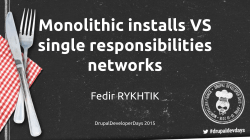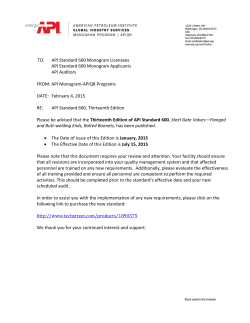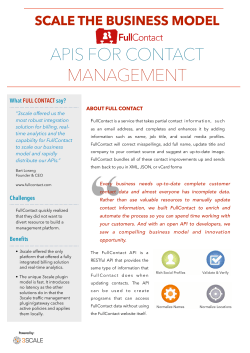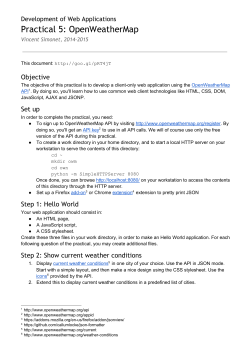
What are microservices?
ROME 27-28 march 2015
Bruno Bossola
MSNOS
a spontaneus network operating system for
microservice architectures
bbossola@gmail.com
bruno.bossola@workshare.com
Hey mate, who are you?
●
Developer since 1988
●
XP Coach 2000+
●
Co-founder and coordinator of JUG Torino
●
Java Champion since 2005
●
VP of Engineering @Workshare.com
Agenda
●
Why microservices?
●
What are microservices?
●
What are the issues?
●
MSNOS to the rescue!
●
demo, demo, demo!
●
msnos.io is open source! (MIT license)
Agenda
●
Why microservices?
●
What are microservices?
●
What are the issues?
●
MSNOS to the rescue!
●
demo, demo, demo!
●
msnos.io is open source! (MIT license)
why microservices?
Why microservices?
●
if you are asking this question you are probably living in this
world:
...The world of
the BLACK
MONOLITH!
why microservices?
Why avoid the monolith?
●
the monolith usually provides HTML pages
–
●
the monolith scares developers!
–
●
these days we want APIs and single page apps
the code base is massive
the monolith is scary to deploy
–
everytime you have to deploy everything!
–
it's a stop-the-world moment
why microservices?
What's the issue here?
●
the monolith code bloats your IDE
●
it locks you into one language/platform
●
adding a new API requires a congress
●
●
●
on deploy the whole database may have to be migrated for a
very small change
running the tests can take hours
it's boring to develop on that s**t
Agenda
●
Why microservices?
●
What are microservices?
●
What are the issues?
●
MSNOS to the rescue!
●
demo, demo, demo!
●
msnos.io is open source! (MIT license)
what are microservices?
What are microservices?
●
independent processes communicating with each other using
language-agnostic APIs
●
small, highly decoupled and focus on doing a small task
●
can be written in any programming language
–
●
we do use Ruby, C#. Java and Javascript
micro means small, very!
–
we run 20 of them on one single machine
what are microservices?
I want to add a file to a group...
sendgrid
thumbs:μs
queues:μs
files:μs
mixpanel
postman:μs
UI:js-app
groups:μs
buckets:μs
marketo
events:μs
intercom
notifications:μs
Java
Amazon S3
Javascript
Ruby
C
what are microservices?
Microservices??
server:linux-eu-001
FATTY:Service
server:linux-eu-002
FATTYFATTY:Service
what are microservices?
Microservices!
server:linux-eu-001
api:users
api:groups
api:files
api:sessions
api:folders
api:members
api:deals
api:tracking
api:notes
server:linux-eu-002
api:pushy
api:postman
api:cachey
api:mobi
api:deals
api:pics
api:seams
api:pools
api:prints
api:loops
api:receipts
what are microservices?
Microservices!
what are microservices?
Many advantages!
●
highly cohesive, loosely coupled
●
clean api contracts and SOC
●
very easy to write and replace
●
self-contained, very easy to deploy
●
scaling can be very focused
●
small releases, less risky to deploy
●
separate databases for separate migrations
what are microservices?
Demo!
●
a simple location service that translates IP in geo-location
●
a more complex service that serves files and folders
what are microservices?
What is the context?
●
you use a microservice architecture
●
microservice are distributed across the world
●
each microservice provide different APIs
●
several instances of the same microservices are available
●
they need to talk to each other to fullfill a task
what are microservices?
Cons!
●
●
Lots of them!
Every microservice is doing one thing, so a lot of
collaboration is required to perform a task
●
Scaling requires considerable effort
●
Frequent duplicated configuration
●
Proxying for external apps is not easy
●
management overhead (more moving parts)
what are microservices?
Few issues ahead!
●
Any insight?
Agenda
●
Why microservices?
●
What are microservices?
●
What are the issues?
●
MSNOS to the rescue!
●
demo, demo, demo!
●
msnos.io is open source! (MIT license)
what are the issues?
Problem #1: how do I find an API?
●
I need to use an API exposed by another microservice:
how do I find the endpoint?
–
I am the Session Tracking microservice and I need to translate
an IP to a geo location
–
I heard that a Location microservice does this
–
How do I know which endpoint I need to call?
●
where is it?
●
what's the nearest?
●
what's the less loaded?
what are the issues?
Issue #2: how do I expose my APIs?
●
Hey, I am online and I want to publish my APIs to
everybody: how can I do that?
–
I am a new service, I am a new instance of an existing service
–
I am ready to receive calls!!
–
How do the other microservices get to know about me? :(
what are the issues?
Issue #3: how do I report issues?
●
OMG I am not able to connect to my database
anymore!!!
–
I need to alert the other microservices around that I cannot
accept calls at the moment!
–
If they knew this, they could call another instance of me that
actually works...
–
How do the other microservices get to know about me being
faulty?
what are the issues?
Issue #4: how do I call from clients?
●
I am a single page app / mobile app and I want to use
some backend APIs
–
How can I make sure the APIs I want to use are proxied and
available on the web?
–
How can I get load the best possible service instance to use?
–
How can I avoid connecting to a “bad” API and be sure that I
will always use a working endpoint?
what are the issues?
In an ideal world...
●
●
●
new microservices APIs are automatically seen and used
by any other microservice
unhealthy microservices do not receive calls
the load is distributed trough advanced strategies (load,
location, availability...)
●
there are no single point of failures
●
add/remove of microservices is transparent
●
“public” APIs are magically proxied to the web
Agenda
●
Why microservices?
●
What are microservices?
●
What are the issues?
●
MSNOS to the rescue!
●
demo, demo, demo!
●
msnos.io is open source! (MIT license)
MSNOS to the rescue!
●
A network operating system for architectures based on
microservices
–
self discovery
–
communication
–
load balancing
–
routing
–
web proxying
–
...and more :)
msnos to the rescue!
What is NOT
●
●
●
A replacement for a deployment mechanism
–
still your job to deploy and run a microservice
–
docker does a good job I heard :)
A replacement for any configuration
–
still your job to configure enough to start
–
it provides a shared key-value store tough :)
An infinite scaling solution
–
works well with a couple of hundreds
–
we are not in the thousands (yet)
msnos to the rescue!
Why do we need this? [1/2]
●
μservices should automatically discover themselves
–
●
●
●
any service can find any api with zero effort
μservices should be able to scale on demand
–
work should be handled in a balanced manner
–
you should be able to spinoff a new instance so that it can
transparently join the cloud and start working
μservices should work across network boundaries
the cloud of services should be deployable across two or more different
physical clouds
msnos to the rescue!
Why do we need this? [2/2]
●
●
●
μservices api should be
exposed automagically to the
external world
μservices public APIs should
be proxied transparently
you should not need a VM for
msnos to the rescue!
How do I use it? [1/2]
●
msnos is a native library you link into your app
Create a cloud, a service,
let the service join the cloud
cloud = new Microcloud(params.uuid());
service = new Microservice(params.name());
service.join(cloud);
RestApi[] { apis = new RestApi[] {
new RestApi("/hello", URI_GREET, port),
new RestApi("/wassup", URI_WASSUP, port),
new RestApi("/checkme", URI_HEALTH, port).asHealthCheck(),
new RestApi("/msnos", URI_MSNOS, port, Type.MSNOS_HTTP),
};
service.publish(apis);
Declare and publish
your service APIs
msnos to the rescue!
What do I get?
●
●
Out of the box fast HTTP reverse proxy
–
fast, non blocking, based on Netty
–
exposes your public APIs to the web
Out of the box WWW gateway
–
●
●
helps discovery across network boundaries
A simple sms-style messaging system
Free live visualization tool for monitoring and basic
management of your cloud
–
available now at msnos.io
msnos to the rescue!
Demo!
Future
●
Release 1.0 (1m)
–
core, proxy, www gateway
●
Native Ruby support (2w)
●
Support for Azure (2w)
●
Completion of distributed configuration (1m)
●
Native .NET support (1m)
●
STUN protocol support - RFC 5389 (tbc)
Q&A
●
●
Msnos code:
–
https://github.com/workshare/ms-nos
–
msnos.io
Myself:
–
●
https://about.me/bbossola / @bbossola
Company
–
https://www.workshare.com
Anticipated Q&A
●
●
Q. Why did you not release a final
version yet?
A. Because, even if we are using it in
production, we still consider it not
final and we prefer to wait in order to
release top-quality code
Anticipated Q&A
●
●
Q. Why don't you simply use a
dynamic DNS to manage
discovery??
A. One of my favourites :)
– a DNS entry does not provide us
enough granularity, as we want to
talk about API endpoints, not
Anticipated Q&A
●
●
Q. Why don't you use ${otherframework}?
A. Well, there are different answer
for each of them, and such
frameworks are becoming more
popular by the minute! Anyway, some
common issues we found so far:
Tech-stuff: features
●
full messaging platform
–
broadcast of messages
–
point-to-point messages
–
reliable messages
●
self discovery of other services
●
publish and locate an API in the cloud
●
debug in the cloud
●
automatic reverse proxying of public APIs
●
sharing configuration within the cloud (wip)
●
events publish/subscribe (future)
how routing works
Ring
WWW Gateway
HTTP
(polling)
Ring
HTTP
(direct)
Microservices
UDP
UDP only
UDP + WWW
UDP + HTTP + WWW
Ring
how proxy works
HTTP
Proxy
RestAPI X
RestAPI Y
RestAPI Z
© Copyright 2025










